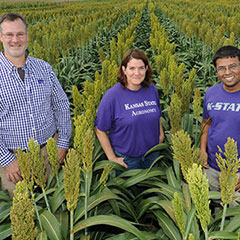August 22, 2017
30-year Study Indicates Kansas Sorghum Needs to Tap Genetic Diversity for Future Heat Stress

Kansas State University scientists have studied 30 years of sorghum production in Kansas and have concluded that the crop needs to exploit greater genetic diversity to handle heat stress should average temperatures rise in the future.
“In terms of leveraging sorghum’s genetic ability to adapt to hotter conditions, we have not invested enough in the breeding pipeline,” said Krishna Jagadish, an associate professor of agronomy and one of the study’s co-authors.
Their work, which is being published this week in the Proceedings of the National Academy of Sciences (PNAS), signals a critical need for the public and private research communities to capitalize on sorghum’s genetic diversity to develop the type of commercial hybrids needed to handle future temperature increases.
“Despite the appreciation for sorghum’s water sipping attributes, there does not seem to be an effort to couple that with needed heat resilience,” said Kansas State University agricultural economist Jesse Tack, who helped analyze sorghum yield data from 408 commercial hybrids grown in 11 Kansas locations between 1985 and 2014.
“Farming systems need tools to combat extreme weather exposure. Adding additional heat resilience to drought-hardy sorghum could be the right tool.”
The researchers’ work provides a historical representation of the genetic material that is in grain sorghum production in Kansas. They note that a major finding is that sorghum yields declined with temperatures higher than 33 degrees Celsius (approximately 91 degrees Fahrenheit), and that climatic change will likely produce an average yield loss of 10 percent for each degree Celsius of warming.
U.S. scientists studying climate change have predicted that much of planet Earth will experience a minimum two degrees increase in temperatures over the next few decades.
“In our current pipeline, we lack hybrids that can tolerate additional heat stress, which is why we think there is not enough genetic diversity in this pool,” Jagadish said.
But Tack said there is plenty of hope to make Kansas and U.S. sorghum more resilient.
“There’s untapped genetic material within sorghum, it’s just not currently in this particular genetic pool,” he said. “Sorghum originates from some of the harshest climates, meaning sorghum diversity should reflect adaptability to harsh weather. It likely exists out there in nature, not necessarily existing only in the wild, but they might be domesticated or existing in experimental trials elsewhere.”
Jagadish said a critical piece of discovering new genetics for heat resilience and moving them into future Kansas and U.S. varieties is having the resources for sorghum breeders to do the work.
“We are at a point where we think the crop is really hardy, it can survive in the harsh conditions, but because of a continued lack of investment in improving it, it has really taken a beating over the years,” he said. “If we do not invest in sorghum, sorghum will not be ready for harsh weather change.
“We want to be in a position where we’re ready for the challenge, but you can’t get a solution in one or two years. It requires a long-term investment.”
Tack added: “One of the main goals of the paper is to say something positive about the future of adaptation. We didn’t know that we were going to find such extreme sensitivity, and when we did, it became clear that while this plant has a reputation for surviving harsh environments, it’s still not immune to heat stress.
“Once you have that finding, you want to say something about the future. We are not trying to cast stones here, rather we are trying to point to a path forward.”
Tack said that the paper reports findings that link heat-stress impacts to various plant-growth stages, which can aid breeders’ efforts in improving resilience.
Kansas State University agronomist Jane Lingenfelser is also a co-author of the PNAS article, which is available online at in full text on the PNAS website.
“I think this is a wake-up call in the context of this is a plant that tends to have a certain reputation for resilience to harsh environmental conditions, and maybe we’ve taken that for granted in terms of investments,” Tack said. “Ultimately we gain traction when this sort of information appears in front of breeders and they make decisions to act on it, but that’s a huge process. We’re talking about things that require funding and investments and that’s going to come from a population much larger than breeders.”
“I would hope that there is wide-ranging interest and it filters up to the people who can push buttons to actually make a difference.”
Sarah Sexton-Bowser, the managing director at Kansas State University’s Center for Sorghum Improvement, said farmers know that sorghum is a strong weather risk management crop because of what they see in their fields.
“Knowing the results of this study conveys that if we want a weather resilient crop, sorghum is the right race horse to invest in,” she said. “The results we need to see in the farmer tool box to combat heat pressure will require strategic investment.”